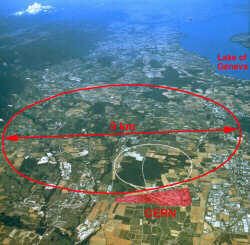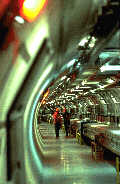



Connections Through Time, Issue 10:
January -March 2001
![]()
 |
28 km (17-mile) underground tunnel near Geneva, Switzerland. |
 |
LEP Tunnel |
The godlike importance ascribed to the Higgs particle (or equivalently, the Higgs field) is because the mass properties of all particles, such as electrons, are created based on their interactions with the Higgs field. Predicted over 30 years ago by physicist Peter Higgs (University of Edinburgh, Scotland) the Higgs field engulfs all other particles in an unseen "ocean-like ether" permeating all space, which causes a type of "drag" that shows itself as mass.
In The
Standard Model of particles and forces, the mass of the fundamental
particles are specified based on previous experiments and theory. From
this basis, all the masses of atoms and molecules can be understood.
However, it seems reasonable to ask why do we have multiple
"fundamental" particles with their various masses - here is where the
Higgs field enters the picture. The following is a description of
the Higgs field from Atlas:
The Riddle of Mass:
The Standard Model proposes that there is another field not yet observed, a field that is almost indistinguishable from empty space.
We call this the Higgs field. We think that all of space is filled with this field, and that by interacting with this field, particles acquire their
masses. Particles that interact strongly with the Higgs field are heavy, while those that interact weakly are light.
The need to "explain" the nature of mass also arose in the context of the Big Bang and how a very very hot and very very small universe of just pure energy could lead to the massive universe we see today. This process is described, including the contribution of Higgs fields, in The Inflationary Universe: The Quest for a New Theory of Cosmic Origins by Alan Guth and Alan Lightman
Without the full context of the theoretical models, all attempts to explain the Higgs field are simplistic, and yet, it seems important to grasp its meaning since this field is so fundamental to our physical universe. Here are the best layperson's explanations we have found, from a contest held in Britain, that places the Higgs field in a more "information-type" context.
Imagine a cocktail party of political party workers who are uniformly distributed across the floor, all talking to their nearest neighbours.
The ex-Prime Minister enters and crosses the room. All of the workers in her neighbourhood are strongly attracted to her and cluster
round her. As she moves she attracts the people she comes close to, while the ones she has left return to their even spacing. Because of
the knot of people always clustered around her she acquires a greater mass than normal, that is she has more momentum for the same
speed of movement across the room. Once moving she is hard to stop, and once stopped she is harder to get moving again because the
clustering process has to be restarted.
In three dimensions, and with the complications of relativity, this is the Higgs mechanism. In order to give particles mass, a background
field is invented which becomes locally distorted whenever a particle moves through it. The distortion - the clustering of the field around
the particle - generates the particle's mass.
If
this theoretical Higgs field/particle was measured, then science has come one
step closer to a fundamental and quantitative understanding of our physical
universe. However, even by
combining the data of four groups analyzing the results of the LEP experiments,
the analysis indicated that the Higgs particle was found with "enhancement above background of less than 3 standard
deviations", but still better than 2 standard
deviations. This is encouraging, but not
sufficient proof for the physics community. The "proof of
discovery" issue was better quantified in a Scientific
American - Science and the Citizen discussion of the Higgs particle:
... the odds that the results were noise were one in 250--a tantalizing result but much too uncertain to proclaim "discovery."
...
Hoping to gain enough data to reduce the odds of error below the one in a million needed for a
discovery, experimenters pleaded for a year's reprieve to LEP's scheduled
dismantling ...
The experiments to claim discovery of the Higgs particle/field will continue in the best spirit of scientific inquiry. However, the LEP collider will not be involved. The CERN managers decided to go ahead with their plans to build the more powerful Large Hadron Collider (LHC) for a cost of about $1.8 billion. The Atlas Experiment, involving a very large particle detector, is a key part of the LHC. This new project will take five years to complete, and it is possible that the Fermi National Accelerator Laboratory outside Chicago, US, may definitively discover the Higgs particle before CERN comes back online with the LHC.
References
Scientists Think They've Glimpsed the 'God Particle'
November 3, 2000
A Massive Mystery
Peter N. Spotts, Staff writer of The Christian Science Monitor
10-05-2000
Has the Higgs Boson Been Seen? Physics Today Online
What exactly is the Higgs boson? Have physicists proved that it really exists? Scientific American - Ask The Experts
Scientific American - Science and the Citizen Higgs Won't Fly: CERN declines a massive opportunity to find the Higgs particle
Collider to Close for Good BBC News November 8, 2000
The Standard Model: The Particle Adventure
Go to another section of this issue:
Intuition:
Consciousness-Intention-Trust Applications:
Associative Remote Viewing (ARV)
![]()